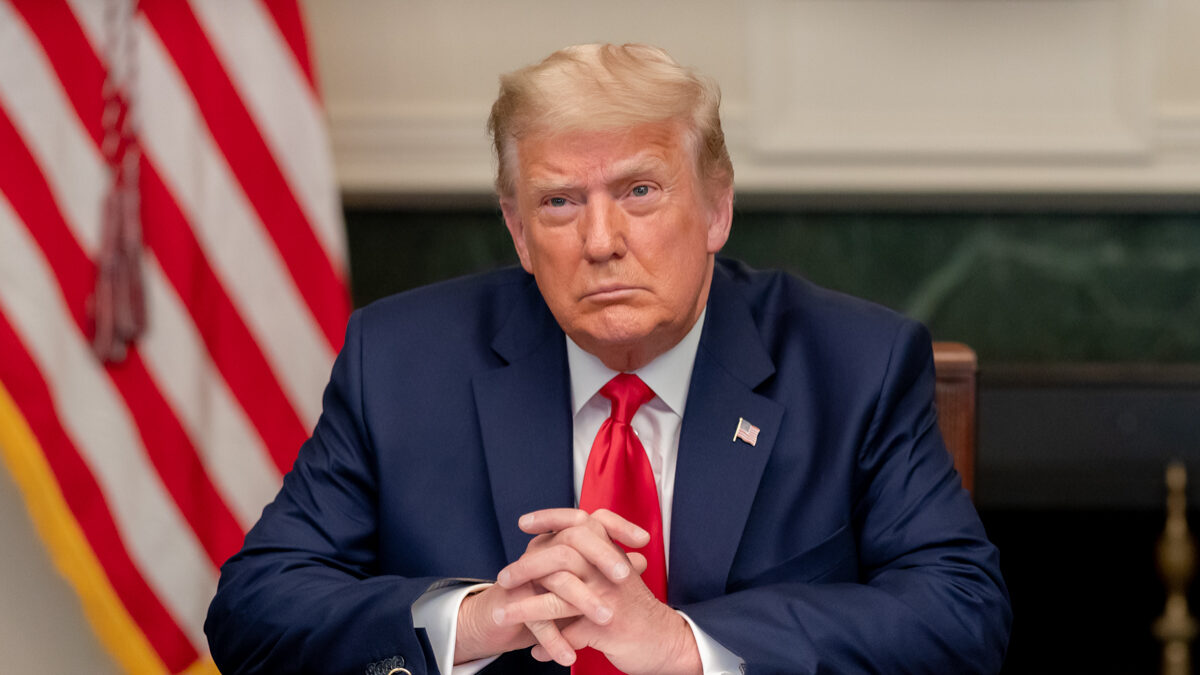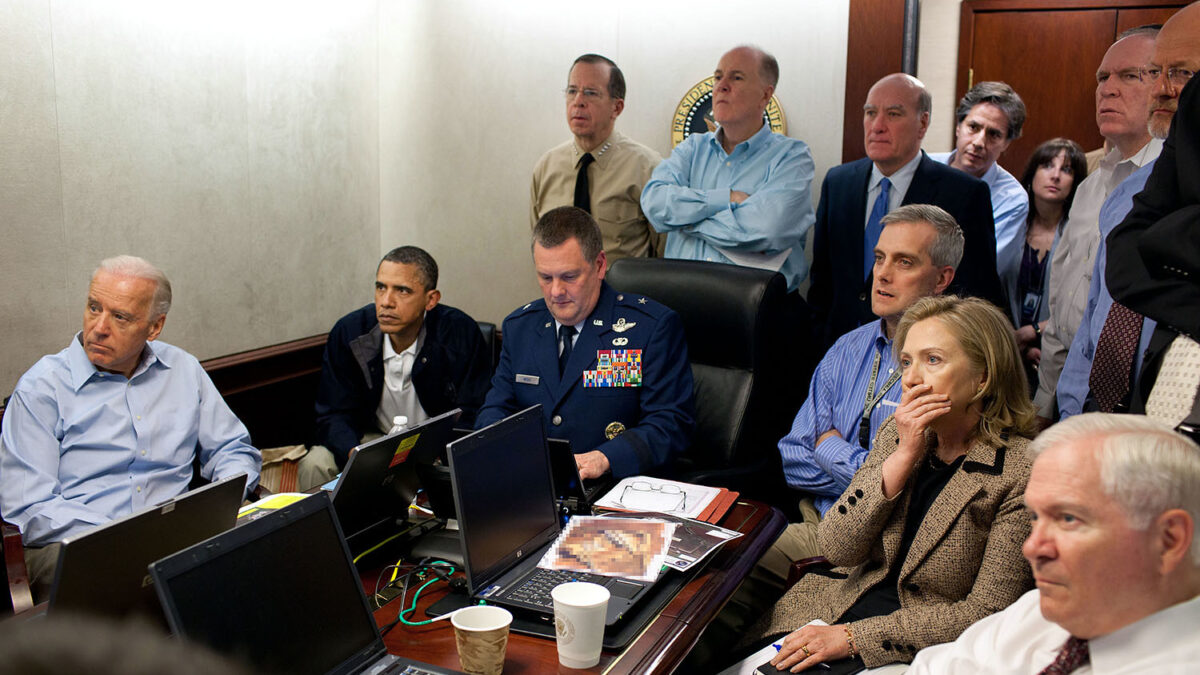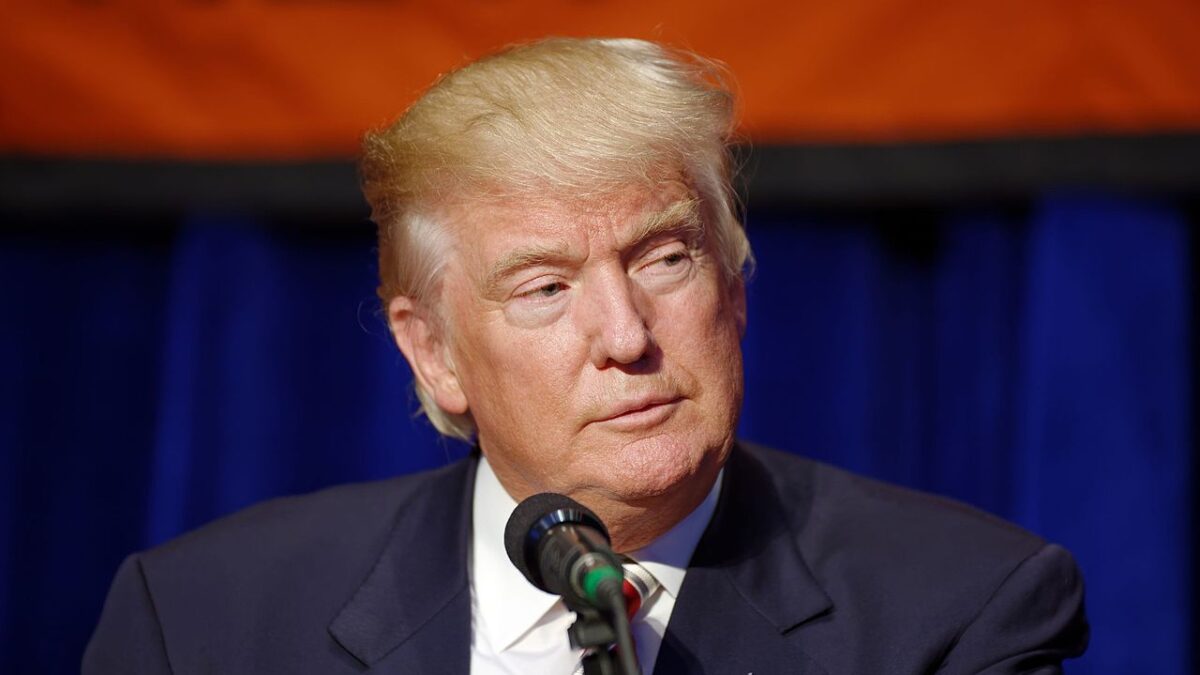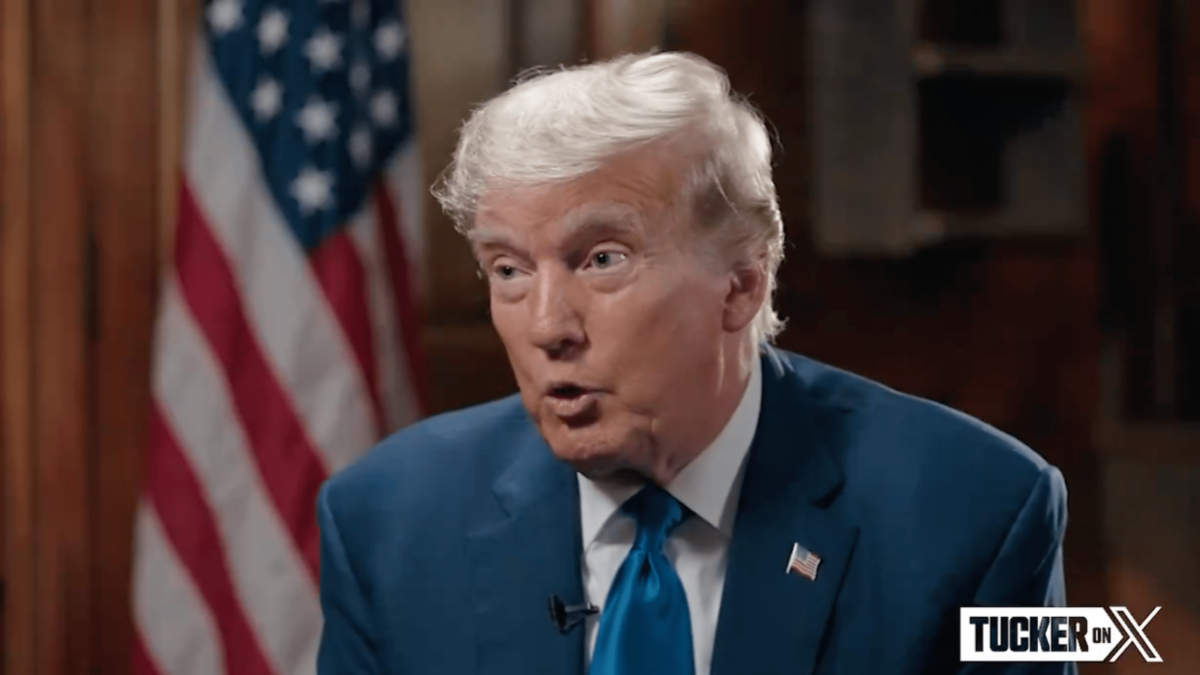Last week, former President Donald Trump filed a sprawling lawsuit against Hillary Clinton and the other main players responsible for the Russia collusion hoax. Here’s your lawsplainer for Trump v. Clinton, et. al.
First, the Facts
The 103-page complaint filed in a Florida federal court on Thursday begins with a synopsis of the Democratic plot to frame Trump as a Russian asset, spurring the Crossfire Hurricane investigation into his presidential campaign and later his administration. Among other things, the lawsuit highlights the Clinton campaign’s hiring of Perkins Coie, alleging the law firm “was tasked with spearheading the scheme to find — or fabricate — proof of a sinister link between Donald J. Trump and Russia.”
According to the lawsuit, Perkins Coie lawyers Marc Elias and Michael Sussmann enlisted others, including the investigative firm of Fusion GPS and its co-founders, Peter Fritsch and Glenn Simpson, and “Neustar, Inc., an information technology company, and one of its top executives, Rodney Joffe.” The complaint then detailed Fusion GPS’s hiring of Christopher Steele, the principal and founder of Orbis Ltd., and Steele’s use of Igor Danchenko as a primary sub-source for the fraudulent Steele dossier that the defendants fed to the FBI and the media to craft the Russia-collusion narrative.
Simultaneously, Joffe and others exploited “their access to non-public data in search of a secret ‘back channel’ connection between Trump Tower and Alfa Bank,” the complaint alleged, but, according to the complaint, after discovering “no such channel existed, the defendants resorted to truly subversive measures hacking servers at Trump Tower, Trump’s private apartment, and, most alarmingly, the White House.” “This ill-gotten data was then manipulated to create a misleading ‘inference’” of Russia collusion,” the complaint charged. That data was then provided to the FBI and CIA, as well as peddled to the media.
In turn, the complaint continued, what Trump called a “small faction of Clinton loyalists” in the Department of Justice and FBI, including James Comey, Andrew McCabe, Peter Strzok, Lisa Page, Kevin Clinesmith, and Bruce Ohr, allegedly abused their authority by, among other things, obtaining the illegal FISA warrant to spy on former Trump campaign advisor Carter Page and to trigger the appointment of Special Counsel Robert Mueller. Together, these schemes caused Trump to incur upward of $24 million to defend against the false charges Clinton and her cronies concocted, the lawsuit alleged as damages.
This summary represents a fraction of the details included in the complaint — and an even smaller sliver of the totality of the facts of SpyGate — but it sets the stage sufficiently to understand the theories Trump’s legal team present: Trump’s lawyers allege a total of 16 separate counts, ranging from RICO claims to state law tort claims.
1. RICO and RICO Conspiracy
In Count I of the complaint, Trump sues Clinton, the Clinton campaign, the Democratic National Committee, Perkins Coie, and lawyers Elias and Sussmann under the Racketeer Influenced and Corrupt Organizations Act, better known as “RICO.” While racketeering, as defined in the statute, constitutes a federal crime, in passing RICO Congress also created a “civil right of action,” meaning those harmed by violations of RICO could sue for damages civilly.
To state a civil RICO claim, a plaintiff such as Trump must allege four elements: (1) conduct (2) of an enterprise (3) through a pattern (4) of racketeering activity. To satisfy the “pattern of racketeering activity element,” a plaintiff must allege: “(1) that defendants committed two or more predicate acts within a ten-year time span; (2) the predicate acts were related to one another; and (3) the predicate acts demonstrate criminal conduct of a continuing nature.”
In his complaint, Trump alleged Clinton, her campaign, the DNC, Perkins Coie, Elias, and Sussmann constituted an “enterprise” within the meaning of the statute. Whether this group, coming together to push the Russia collusion hoax, qualifies as a RICO enterprise presents an interesting question, but one ultimately irrelevant, as will soon be seen, given the underlying predicate acts Trump alleges.
Specifically, Trump alleges two possible “predicate acts” or underlying crimes, the defendants allegedly committed, which his legal team then argues establishes a RICO violation. First, the complaint alleges that the RICO defendants conspired with Neustar and Joffe to “abuse and exploit” “non-public and highly sensitive data sources,” which gave the defendants access to “proprietary, sensitive and confidential information, data and/or knowledge.” That sensitive and confidential information, according to the complaint, constitutes “trade secrets,” and thus by “appropriating” that information,” Trump alleges the defendants committed a crime in violation of the Defend Trade Secrets Act.
The second “predicate act” or underlying crime alleged by Trump is “obstruction of justice,” which criminalizes the corrupt influencing or impeding of “the due administration of justice.” In alleging this act, Trump points to the defendants conspiring with the other players to present “misleading and inaccurate” information to law enforcement officials, which “obstructed” and “influenced” the Crossfire Hurricane investigation.
Of these two potential crimes, only the second seems to stand a chance of satisfying the requisite RICO standard of alleging a pattern of criminal conduct, as the trade secrets alleged seem too much of a stretch under the law — more on that below. But even though the allegations of obstruction of justice arguably qualify, the statute of limitations will still stymie Trump.
Civil RICO claims are subject to a four-year statute of limitations, and that four-year time period begins to run “when a plaintiff knew or should have known of his injury. “In other words, the ‘discovery of the injury,’ not discovery of the other elements of a claim, is what starts the clock.”
In this case, Trump arguably knew before March 2018 — four years before Trump filed his RICO claim — of his injury given the appointment of Robert Mueller occurred in May 2017. But, at a minimum, by January 2018 Trump had actual knowledge of several aspects of the entire plot, with Devin Nunes, the then-chair of the House Intelligence Committee, detailing in a memo the Clinton campaign’s role in paying for the Steele dossier and highlighting the DOJ and FBI’s abuse of the FISA court. Under these circumstances, it seems likely the court will dismiss Trump’s RICO claim as barred by the statute of limitations.
In addition to the RICO claim, Trump alleged in Count II that a slew of defendants conspired to violate RICO. Those defendants included Debbie Wasserman Schultz, the former DNC chair; Charles Halliday Dolan, Jr., a Clinton backer who fed Danchenko false information that ended up in the dossier; Jake Sullivan, Clinton’s foreign policy advisor during the 2016 campaign; John Podesta, the chair of the 2016 Clinton campaign; Robert Mook, the Clinton campaign manager; Phillipe Reines, a communications advisor to Clinton; Fusion GPS, its owners (Simpson and Fritsch) and its contractor, Nellie Ohr; Bruce Ohr, Nellie’s husband and a DOJ employee; Orbis Business Intelligence, Ltd., its founder Steele, and Danchenko, a source for Steele; and tech company Neustar, Inc., and its agent Rodney Joffe.
While RICO makes it illegal to conspire to violate the substantive provisions of RICO, by either agreeing to the overall objective of the conspiracy or by showing that the defendant agreed to commit two predicate acts, in this case, Trump’s RICO conspiracy claim will likely fail for the same reason his RICO claim will be dismissed — it was untimely and thus is barred by the statute of limitations.
2. Injurious Falsehood and Conspiracy to Commit Injurious Falsehood
Trump’s next two claims concern the alleged state law tort of “injurious falsehood” and conspiracy to commit injurious falsehood, alleged respectively in Counts III and IV. (Count III’s heading inaccurately references 18 U.S.C. 2701, a separate claim Trump presents later).
Injurious falsehood is a state claim much like defamation but designed to compensate an individual for injury to his economic interests. Losses recoverable here are those “directly and immediately” resulting “from the falsehood’s effect on the conduct of third persons and the expenses incurred to counteract the publication.”
To state a claim for injurious falsehood in Florida, the complaint must allege “(1) a falsehood; (2) published or communicated to a third party; (3) the defendant knew that the falsehood would likely induce others not to deal with the plaintiff; (4) the falsehood does play a material and substantial part in inducing others not to deal with the plaintiff; and (5) special damages.”
In this case, Trump claims Clinton, Sussmann, Steele, Danchenko, Sullivan, and Schultz on multiple occasions disseminated false and damaging information indicating Trump was colluding with Russia and that as a result of these falsehoods Trump spent more than $24 million to counter the claims. It is unclear whether that type of alleged harm qualifies as an “economic interest” for purposes of an “injurious falsehood” claim, which typically concerns false statements disparaging another person’s property or business. But, in any event, as with his RICO claim, Trump must first clear the statute of limitations.
Florida applies a two-year statute of limitation for defamation-like claims, meaning any injurious falsehoods made before March 2020 would be time-barred. In this case, while Trump highlights many false accusations, they nearly all date to 2018 or before. The one exception appears to be Clinton’s June 2021 appearance on the “Morning Joe” show on MSNBC when she declared, “We don’t have Trump as a spokesperson for Putin, anymore,” adding “after the disastrous Trump presidency, in which he gave Putin a green light to do whatever he wanted to don, once Trump was elected, of course.”
It seems unlikely the court will view these statements as sufficient to qualify as a falsehood likely to induce others not to deal with Trump, and thus this claim is likely to fail as well. The conspiracy claim in Count IV is likely to also fail because the alleged injurious falsehoods fall outside the statute of limitations.
3. Malicious Prosecution and Conspiracy to Commit Malicious Prosecution
In Count V Trump sues Sussman, Elias, Danchenko, Fritsch, Simpson, Nellie Ohr, Steele, Joffe, and DOJ and FBI agents James Comey, Andrew McCabe, Peter Strozk, Lisa Page, and Kevin Clinesmith for malicious prosecution, with Count VI adding additional defendants and alleging they conspired to maliciously prosecute Trump.
To prevail in a malicious prosecution case, a plaintiff must typically establish six elements: “(1) an original judicial proceeding against the present plaintiff was commenced or continued; (2) the present defendant was the legal cause of the original proceeding; (3) the termination of the original proceeding constituted a bona fide termination of that proceeding in favor of the present plaintiff; (4) thee was an absence of probable cause for the original proceeding; (5) there was malice on the part of the present defendants; and (6) the plaintiff suffered damages as a result of the original proceeding.”
In this case, although the defendants allegedly caused the Mueller investigation into Trump, no judicial proceedings were instituted against the former president. Accordingly, his malicious prosecution claim seems doomed.
Trump also alleged a conspiracy to commit malicious prosecution, adding in Clinton, Podesta, Mook, Resines, and others. To recover for a civil conspiracy, a plaintiff must show an agreement between two or more parties to do an unlawful act or a lawful act by unlawful means, doing some overt act in pursuance of the conspiracy and damage to the plaintiff as a result. However, because there was no institution of criminal proceedings, this claim will fare no better.
4. Computer Fraud Abuse Act and the Stored Communications Act
Trump added claims in his complaint under the Computer Fraud and Abuse Act (CFAA) in Count VII against Neustar, Joffe, the DNC, the Clinton campaign, Clinton, Perkins Coie, and Sussmann, and under the Stored Communications Act (SCA) in Count IX against Neustar and Joffe.
The CFAA provides that “whoever . . . intentionally accesses a computer without authorization or excessed authorized access, and thereby obtains . . .information from any protected computer’ violates the CFAA.” A person injured by that unauthorized access may file a civil suit under the CFAA, but must have suffered a loss of at least $5,000, or meet other statutory requirements.
Similarly, the SCA makes it unlawful to “intentionally access[] without authorization a facility through which an electronic communication service is provided” and thereby obtain “access to a wire or electronic communication while it is in electronic storage.” Under the SCA, in addition to a defendant exceeding his authorized access, the electronic communications must be in “electronic storage.” The statutory meaning of “electronic storage” is quite narrow, applying only to electronic communications in the “middle of transmission” or “saved for backup purposes.”
Both Trump’s Computer Fraud and Abuse Act and Stored Communications Act charges face a serious hurdle in the Supreme Court’s recent holding in Van Buren, wherein the high court held that the CFAA’s term “exceeds authorized access” means “an individual ‘exceeds authorized access’ when he accesses a computer with authorization but then obtains information located in particular areas of the computer—such as files, folders, or databases—that are off limits to him.”
According to the Supreme Court, “the CFAA . . . does not target those who misappropriate confidential information or trade secrets they were authorized to learn about, read, or otherwise obtain, or those who misappropriate computer files they were perfectly authorized to open, view, or otherwise access.”
Following Van Buren, lower courts have interpreted the SCA’s “without authorization” language consistent with that case. This means for Trump’s civil suit to succeed, the defendants must have accessed protected computers or electronic storage that they were not legitimately provided access to. The question the court will need to decide, then, is whether Trump’s allegations are sufficient to support the possibility that Joffe accessed computer information or electronic storage (as defined by the statute) that he had no authority to access. If, instead, Joffe had the authority to access the data he allegedly used to craft the Alfa Bank and Yota cell phone hoaxes, there is no violation of the CFAA or the SCA under Van Buren.
In his complaint, Trump alleged the defendants “hacked” the computers, which might be considered sufficient, although it is questionable whether Joffe accessed computer systems without authority. This question will likely be the main focus of this case moving forward.
If the court finds Trump sufficiently alleged violations of the CFAA and the SCA, the claims will likely survive the statute of limitations challenges because those statutes provide a lawsuit may be filed within “two years from the date the claimant first discovered or had a reasonable opportunity to discover the violation.” This statutory language differs from the other governing statutes of limitation, which begin running at the time of injury. Here, the clock does not start ticking until Trump discovered the alleged violation. And in this case, Trump only learned of the alleged violations by Joffe within the last year, following the indictment of Sussmann.
5. Theft of Trade Secrets Act
In Count VII, Trump sued Neustar, Joffe, Perkins Coie, Sussmann, the Clinton campaign, the DNC, and Clinton personally alleging they violated the federal Theft of Trade Secrets Act. Neustar and Joffe, Trump alleged, illegally obtained Trump’s confidential records in the form of the Domain Name System or “DNS” data that showed the computer systems Trump-related computers communicated with. The other named defendants conspired with Neustar and Joffe to misappropriate Trump’s confidential records and injure Trump, according to the complaint.
This count seeks recovery under the federal Defend Trade Secrets Act which creates “a private right of action” or the right for an individual to sue civilly under certain circumstances. But to sue under the Defend Trade Secrets Act, at a minimum a “trade secret” must be at issue.
And “confidentiality alone does not a trade secret make.” Rather, a trade secret exists if an owner “takes reasonable measures to keep the information secret,” and “the information ‘derives independent economic value, actual or potential, from not being generally known.” In other words, the “secret” information provides the owner an economic advantage.
Typical examples include formulas for Kentucky Fried Chicken or Coca-Cola, or Google algorithm, but trade secrets can also include customer lists with contacts and product and pricing information. A court is extremely unlikely to find that the DNS data allegedly mined “derives independent economic value” or otherwise constitutes a trade secret, and thus this claim will likely be tossed as well.
6. Agency and Respondeat Superior
The final counts all seek to hold the defendants responsible for the conduct of others, with Count X, entitled “Agency,” attempting to hold Clinton responsible for the conduct of those acting on her behalf, known legally as “agents.” General principles of agency law provide that if a principal directed or authorized a wrongful act, or ratifies the act after the fact, he (or in this case she), is legally liable for the conduct.
The principle of respondeat superior also finds its origins in agency law and holds that employers are vicariously liable for torts committed by employees within the scope of their employment. Vicarious liability is a form of strict liability, and the employer is liable for an employee’s wrongful conduct even if the principal did not direct or authorize the conduct and even if the employee acted without the employer’s knowledge. Under the principle of respondeat superior, once an individual is determined to be an employee, the question of concerns asks whether the employee acted within “the scope of employment” when committing the alleged tort.
In Trump’s lawsuit, in Counts XI through XVI, he seeks to hold the business entities of Perkins Coie, DNC, the Clinton campaign, Neustar, Orbis, Fusion GPS, and Orbis liable for the conduct of their respective employees based on this doctrine. However, without an underlying wrong by an employee in the first instance, there can be no respondeat superior liability. Thus, the first question is whether Trump properly alleged an employee of the above enterprises committed a wrong for which the law provides a remedy. As detailed above, most of Trump’s legal theory seems doomed, making these claims futile as well.
Next Steps
It will be some time, however, before anything substantive takes place in Trump v. Clinton. Trump will need to serve the defendants first, although before he does, it is possible that the judge randomly assigned to the case, Judge Donald Marsh Middlebrooks, will recuse from the case to avoid an appearance of bias since he is a Bill Clinton appointee. If he doesn’t recuse, it is likely Trump’s attorneys will file a motion seeking his recusal.
Following service, the defendants are likely to immediately seek dismissal of the complaint for these reasons noted above, or other reasons, but Trump will have an opportunity to amend the complaint to address any defects. Here, it is at least plausible that he will be able to tweak the case enough to keep some of his claims alive for a bit, most likely his Computer Fraud Abuse Act and Stored Communications Act claims given that it is not yet clear what data Joffe allegedly accessed.
Sadly, though, Trump may in the end join Svetlana Lokhova and Alfa Bank as victims of Spygate for whom the legal system provided no relief. There is still hope for justice for Carter Page, though.









